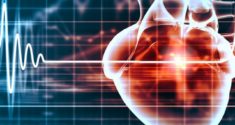Disruption of the circadian rhythm, which naturally changes on a 24-hour cycle, has been linked to heart disease, but it is unclear how this leads to the condition. A research team at Baylor College of Medicine and collaborating institutions investigated the function of the protein Rev-erbα/β, a key component of the circadian clock, in the development of heart disease in animal models and human patients. The team reports in the journal Circulation that Rev-erbα/β mediates a normal metabolic rhythm in cardiomyocytes that allows the cells to prefer lipids as an energy source during the animal’s resting phase, in mice during the day. Removal of Rev-erbα/β disrupts this rhythm, reducing the ability of cardiomyocytes to utilize lipids during rest, and leading to progressive dilated cardiomyopathy and fatal heart failure.
The Role of the Circadian Clock in Heart Disease
“We investigated how the Rev-erbα/β gene affects cardiac metabolism by specifically knocking it out in mouse heart muscle cells,” said co-author Dr. Zheng Sun, associate professor of medicine, Division of Endocrinology, Diabetes and Metabolism, and Molecular and Cellular Biology at Baylor University. “The absence of the gene led to progressive heart damage that resulted in heart failure.” To understand how Rev-erbα/β exerts its effects, the team analyzed gene and protein expression as well as a comprehensive panel of metabolites and lipids during both waking and sleeping hours. They found that the Rev-erbα/β gene is only highly expressed during sleep phases and that its activity is linked to lipid and sugar metabolism.
 “The heart responds differently to different energy sources depending on the time of day,” explains co-author Dr. Lilei Zhang, Assistant Professor of Molecular Genetics and Human Genetics and Molecular Physiology and Biophysics at Baylor University. During the resting phase, which is at night in humans and during the day in mice, the heart uses fatty acids released from fats as its main source of energy. In the active phase, which takes place during the day in humans and at night in mice, the heart shows a certain resistance to carbohydrates from food. The researchers found that hearts without Rev-erbα/β have metabolic disorders that limit the use of fatty acids in the resting phase and that too much sugar is consumed in the active phase. The researchers hypothesized that hearts with Rev-erbα/β-knockout cannot burn fatty acids efficiently during the resting phase and therefore do not have enough energy to beat. “This lack of energy would likely lead to changes in the heart that would result in progressive dilated cardiomyopathy,” said Sun, a member of the Dan L Duncan Comprehensive Cancer Center.
“The heart responds differently to different energy sources depending on the time of day,” explains co-author Dr. Lilei Zhang, Assistant Professor of Molecular Genetics and Human Genetics and Molecular Physiology and Biophysics at Baylor University. During the resting phase, which is at night in humans and during the day in mice, the heart uses fatty acids released from fats as its main source of energy. In the active phase, which takes place during the day in humans and at night in mice, the heart shows a certain resistance to carbohydrates from food. The researchers found that hearts without Rev-erbα/β have metabolic disorders that limit the use of fatty acids in the resting phase and that too much sugar is consumed in the active phase. The researchers hypothesized that hearts with Rev-erbα/β-knockout cannot burn fatty acids efficiently during the resting phase and therefore do not have enough energy to beat. “This lack of energy would likely lead to changes in the heart that would result in progressive dilated cardiomyopathy,” said Sun, a member of the Dan L Duncan Comprehensive Cancer Center.
To test this hypothesis, the researchers investigated whether restoring impaired fatty acid utilization would improve the condition. “We know that fatty acid utilization can be controlled by lipid-sensitive metabolic pathways. We hypothesized that an increased supply of lipids in Rev-erbα/β-knockout mice would possibly activate the lipid-sensitive metabolic pathways, overcome the defect and thus enable the heart to obtain energy from lipids,” Sun explained. The researchers fed Rev-erbα/β-knockout mice one of two high-fat diets. One diet was predominantly high-fat. The other was a high-fat, high-sugar diet similar to the human diet that promotes obesity and insulin resistance. “The high-fat, high-sugar diet partially attenuated the heart defects, while the high-fat diet did not,” said Sun. “These results support the notion that the metabolic defect that prevents heart cells from using fatty acids as fuel is responsible for most of the cardiac dysfunction we observe in the Rev-erbα/β-knockout mice. Importantly, we were also able to show that correcting the metabolic defect can help improve the condition.
Clinical Implications for the Obesity Paradox and Chronotherapy
This work has three clinical implications, according to Sun. First, they analyzed molecular clock function in heart tissues from patients with dilated cardiomyopathy who had received a heart transplant to investigate whether clock function is related to the severity of cardiac dilatation in humans. Tissue samples were taken at different times of the day and the ratio of gene expression of the circadian genes Rev-erbα/β and Bmal1 was calculated to determine a chronotype. They found that the cardiac chronotype correlates with the severity of cardiac dilation. The second conclusion is that obesity and insulin resistance, long-known clinical risk factors for heart failure, may paradoxically protect against heart failure within a certain time window, probably by providing fatty acids at rest.
Finally, the researchers investigated the possibility of pharmacologically influencing fatty acid and sugar metabolism to improve the condition. They found that while drugs can help restore the altered metabolic pathways, it is important to administer the drugs in accordance with the internal circadian rhythm of the corresponding metabolic pathways. If the drugs were administered out of sync with the metabolic pathway they were supposed to restore, the treatment did not improve the heart condition.
These results underline the importance of chronotherapy, i.e. timing the administration of medication to the circadian rhythm, not only in this study but also for many other drugs. “Of the 100 most prescribed drugs in the US, at least half have a mechanism of action related to the circadian rhythm,” said Zhang. “This means that these drugs are only effective if they are taken at certain times. Unfortunately, this is not the case. We want to emphasize the importance of taking the circadian rhythm into account when taking medication.”








